Dangergroups: The Best Position Groups Michigan Will Play In 2014

Note: I'll be off for the next week for a vacation that serendipitously coincides with the Art Fair invasion of Ann Arbor. Have a great week, everyone. Townies, get out while you still can.
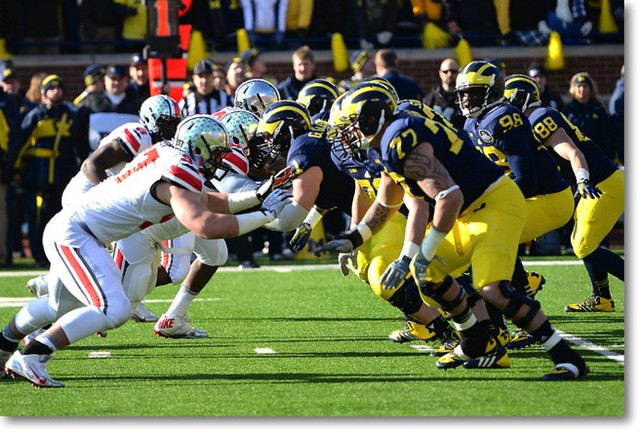
Bryan Fuller/MGoBlog
HTTV is out, Draftageddon is in full swing, and there's nary a non-baseball sport happening right now.* Armed with the knowledge from those first two and the boredom of the third, it's as good a time as ever to do some football opponent overviews. After doing extensive—some would say excessive—amounts of research on Michigan's opponents, here are the five most dangerous position groups the Wolverines are slated to face this year, plus one with the potential to be very good that I felt obligated to include since I had zero non-conference opponents on the list. Let's begin with the obvious.
Ohio State's Defensive Line
Joey Bosa, Adolphus Washington, Michael Bennett, Noah Spence. All four were composite top-60 overall recruits; Washington and Spence were both consensus five-stars, and the other two are already proven collegiate stars after Bosa emerged as one of the best freshmen at any position in the country last year. You'd be hard-pressed to find a better starting front four in the country; only Washington is a new starter, and he's talented enough that last year's starting DT, Joel Hale, volunteered to move to offensive guard this offseason after refusing the same switch a year prior.
As SBNation's Bill Connelly noted in his Ohio State preview, the Buckeye defensive line was surprisingly mediocre by advanced metrics last year, both because of the ugly play in the back seven and a lack of quality depth behind the starters up front. After losing All-American linebacker Ryan Shazier and top cornerback Bradley Roby to the NFL, the former issue may still be, well, an issue. The depth along the line, however, should be better this year; Tommy Schutt, Michael Hill, and Donovan Munger provide plenty of talented options at defensive tackle, while redshirt freshman Tyquan Lewis and blue-chip true freshman Jalyn Holmes should give the Buckeyes two quality backups in addition to senior Steve Miller, who had three sacks in limited time last year.
At the very least, this is a unit that will be very tough to handle in passing situations. If the addition of defensive coordinator Chris Ash shores up the problems that plagued OSU's run defense—tackling with arms would be a good place to start—then this could be a group that keeps offensive coordinators up at night.
Maryland's Receivers
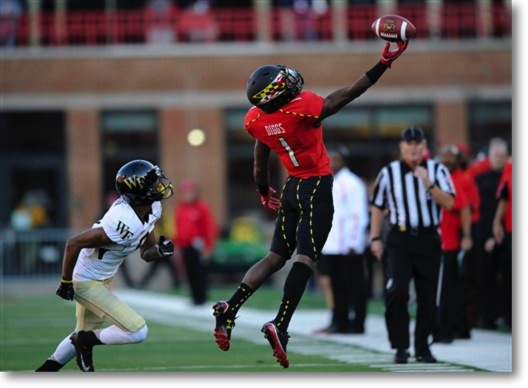 |
| Yeah, it would've been nice to get this guy (via) |
Injuries limited Maryland's two best receivers to just seven games apiece last season. In the midst of such turmoil, however, the Terrapins found they had tremendous depth out wide, and the experience their backups-turned-starters gained last year will prove quite valuable in 2014.
The headliners, of course, are former five-stars Stefon Diggs and Deon Long, who both would've been serious threats to crack the 1,000-yard mark in 2013 if their seasons weren't cut short. Both are now healthy, and they give Maryland the most explosive pair of receivers in the conference.
The supporting cast is stellar, as well. Levern Jacobs emerged as the team's go-to guy when Diggs and Long went down, recording 46 catches for 640 yards on a very impressive 9.0 yards per target; that wasn't the product of the more hyped receivers taking attention away from Jacobs, either, as he recorded two 100-yard efforts as the team's top option. Sophomore-to-be Amba Etta-Tawo was just as explosive (9.1 YPT) on 31 receptions—he also surpassed the century mark twice in the latter half of the season. 6'3" junior Nigel King (33 receptions, team-high four TDs) gives the team a bigger possession receiver, while fellow junior Marcus Leak reportedly excelled in the spring.
There are only a few issues with this group, two of which aren't their fault. Quarterback C.J. Brown is a dual-threat type with some accuracy issues—his middling 59% completion rate in 2013 was still a major improvement over his 49% mark in 2011 (he missed 2012 due to injury). There's the question of how to keep all these receivers happy—there are five proven targets and only one ball to go around. Then there's the issue actually inherent in the receiving corps: among the players listed above, only King stands above 6'1", and Maryland had serious issues scoring touchdowns in the red zone last year. A below-average offensive line had a lot to do with that problem, however, making this some serious nit-picking. This is an outstanding group that has so many options they'll expose any secondary with a major weak point.
Penn State's Tight Ends
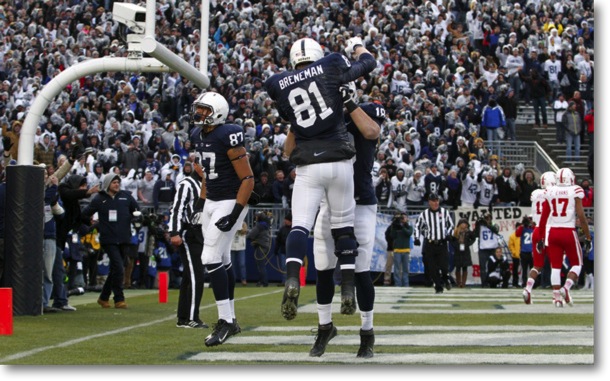 |
| Three PSU TEs caught at least 15 passes in 2013 (via) |
While Allen Robinson deservedly drew most of the attention among Penn State's pass-catchers in 2013, QB Christian Hackenberg was fortunate to have a group of three excellent tight ends—Jesse James, Kyle Carter, and Adam Breneman—all of whom return this fall. Each caught at least 15 passes last year, and their collective numbers should go up as the Nittany Lions look to replace Robinson's 97(!) receptions.
At 6'7", 257 pounds, James provides a huge target, solid blocking, and the most game experience at the position. With eight TDs over the last two years, he's a major threat in the red zone, and he'll be a starter either in name or function.
The other starter—given PSU's personnel, they'll trot out a ton of two-TE sets—should be sophomore Breneman, who displayed NFL potential last year after recovering from a torn ACL that cost him his senior season of high school ball and five-star status on the recruiting sites. He bounced back to catch 15 of his 19 targets for 186 yards (a team-high 9.8 YPT) with three touchdowns; he can split out, work the middle of the field, and like James he must be accounted for near the end zone.
Breneman ate into a serious amount of Carter's production last season. Carter recorded 36 receptions, second on the team despite playing just nine games, as a freshman in 2012; last year, that number dipped to 18, and Breneman is poised to take on an even bigger role now that he's well removed from the ACL injury. That makes Carter by far the best #3 tight end in the conference, and you can bet James Franklin and Co. will find ways to utilize such a deep position group.
Michigan State's Secondary
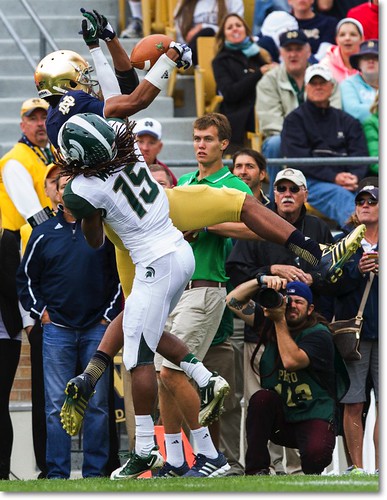 |
| No, BiSB, I refuse to put another picture of Kurtis Drummond on this site (via) |
With two starters gone from the secondary, including first-round corner Darqueze Dennard, some of this is assuming that Pat Narduzzi's scheme and talent development will continue to produce outstanding results. After the past few years, however, that feels like a very safe assumption, and there's no shortage of talent among State's back four.
Kurtis Drummond, as BiSB is sure to remind you, is the best safety in the conference and a very safe bet to go in the first round of next year's NFL draft. He led that defense in solo tackles (49), even managing to chip in 3.5 TFLs, picked off a team-high four passes, and broke up six more. There isn't a more complete safety in the country, and his discipline and play recognition allows Narduzzi to run his hyper-aggressive Cover 4.
Junior Trae Waynes steps into Dennard's #1 corner spot, and he looks more than ready for the role after posting five PBUs and three INTs of his own in 2013. Like Dennard, Waynes has the aggressive-coverage-bordering-on-interference thing down pat—before you complain, Michigan very much wants their corners to do the same this year—and he got tested plenty as teams looked to avoid Dennard last year; despite seeing plenty of action, he held up very well.
Darian Hicks currently leads a group of three sophomores competing for the other corner spot, while redshirt freshman Jalyn Powell made a surprise spring push for the starting strong safety spot, where junior R.J. Williamson—who played a good deal last year rotating in for now-graduated SS Isaiah Lewis—was expected to take over. With that much competition (and that much Narduzzi), don't expect the MSU secondary to take much of a dip this year, if any.
Indiana's Offensive Backfield
 |
| Sudfeld and Coleman are one of the B1G's best backfield duos (via) |
This would've been an even easier pick if dual-threat QB Tre Roberson hadn't transferred over the offseason, but that move may actually be a good sign for Indiana if it means the more polished passer from last year's two-QB rotation, Nate Sudfeld, is poised for a breakout season.
As a sophomore in 2013, Sudfeld completed 60% of his passes at 7.8 yards per attempt with 21 TDs to just nine INTs. Those numbers look more impressive when considering Roberson vultured a lot of his touchdown opportunities and Sudfeld's presence in the backfield tended to tip pass for teams defending the Hoosier attack. While Indiana loses a lot in the receiving corps, Sudfeld should improve now that he's not looking over his shoulder after every off-the-mark pass, and he's got a go-to receiver in productive slot bug Shane Wynn.
The real star of the high-flying Hoosier offense, however, is running back Tevin Coleman, who'd be getting a lot more hype if he didn't play in the same conference as Wisconsin's Melvin Gordon and Nebraska's Ameer Abdullah. Coleman rushed for 958 yards and 12 TDs on just 131 carries (7.3 YPC); he was coming off a 215-yard performance against Illinois when he missed the final three games of the season with an ankle injury. When healthy, he's explosive enough to leave MSU's defense (and their fans) agape. The numbers are rather astounding [emphasis mine]:
But the primary reason I can't worry too much about Indiana's offense is Tevin Coleman. Highlight Yards basically look at a runner's explosiveness once he reaches the second level of a defense. Combining that with Opportunity Rate (the frequency with which you reach said second level), we get a pretty good idea for what kind of back you are. Coleman's 35.9 percent Opportunity Rate was nothing special, but no one in the country was more explosive.
Of the 199 FBS players with at least 100 carries in 2013, only seven averaged 8.0 highlight yards per opportunity or greater. Boston College's Andre Williams and Missouri's Henry Josey averaged 8.0, Maryland's C.J. Brown and Ohio State's Braxton Miller averaged 8.4, West Virginia's Dreamius Smith and UL-Lafayette's Elijah McGuire averaged 8.6 ... and Tevin Coleman averaged 12.0. His average was 40 percent better than the second best. He had 14 carries of at least 20 yards (only 12 players had more), and he had eight of at least 40 (most in the country). He is unlit dynamite every play he's on the field.
Coleman is the ideal back for Kevin Wilson's spread offense, and his production should only go up after he split carries with now-graduated back Stephen Houston last season. IU may lean on him more as they figure out how to replace the lost production among their receivers; Coleman should be up to the task.
Dark Horse: Notre Dame's Offensive Line
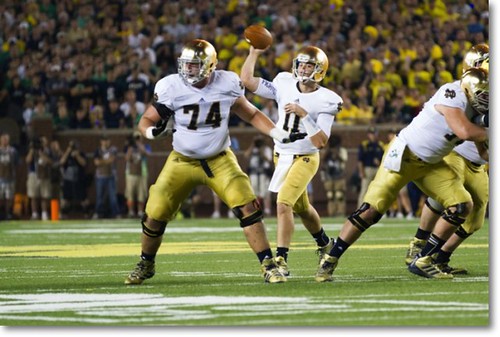 |
| Christian Lombard and Co. made life easy for Tommy Rees last year (via) |
After losing their two most experienced linemen, including first-round left tackle Zack Martin, I'm not quite ready to place Notre Dame's OL among the above groups, but there's a good chance I'll look stupid for not doing so. The Irish still return six linemen boasting a combined 54 starts, and the talent level is among the best in the country. They finished second in adjusted sack rate and 22nd in adjusted line yards last season; in all likelihood, they're reloading, not rebuilding.
Right guard Christian Lombard and center Nick Martin (Zack's younger brother) are the senior anchors of the line, and while both missed time to injury last year, they should be healthy for the fall. The projected starter at left guard, Steve Elmer, played ten games in 2013—including four starts in place of Lombard—and held up remarkably well for a true freshman; at this trajectory, he's a future star.
While there's a little more uncertainty at tackle, the potential is very high there, as well. Junior Ronnie Stanley, a former top-150 overall recruit, is slated to take over for the elder Martin at left tackle after starting all 12 games at right tackle last season. The only major question mark on the line is at right tackle, where 2013 four-star recruit Mike McGlinchey is penciled in as the starter. If he can't cut it in his first year on the field, two other four-star recruits from that class, Hunter Bivin and Colin McGovern, are there to step in as needed. While losing Zack Martin is a major blow, it's one that Notre Dame should be able to withstand.
-----------------
*MLS fans, call me when there's a team in Detroit.
Trae Waynes is viewed to be the better CB of the two when Dennard was on the team before he got drafted at 1st round by the Bengals. Waynes is a better athlete and has higher ceiling than Dennard.
Kris Drummond is another S who is a potential 1st rounder but could very well be the 1st S taken in the draft (Still think Landon Collins is the best S in 2015 draft). In other words, MSU secondary was stacked last year.
Hopefully our lines on both sides of the ball can come together. It feels like we've got the talent at the skill positions. We just need to play well in the trenches.
What a novel opinion, Lovar.
Comments